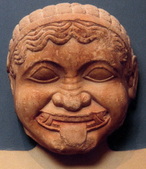The Rape of Medusa Interpreted
Introduction
Like all Greek myth, the story of Medusa develops through time. As each author embellishes the tale, we gain further insight into the young maiden’s plight. Unlike other myths, Medusa’s tale does not morph into complex variations. There are only two versions. So, let's collect the pieces and compare the two versions to understand what this story is trying to tell us.

Legend 1: It was no secret that Medusa's beauty was not earthly. She was divinely magnificent and mesmerized anybody who laid his eyes on her. But being the virgin priestess of the shrine of Athena, she could never experience the glorious warmth and beauty bestowed on earth by the sun as the face of Helios. The Greek deity of the sun could almost never be seen in her northern sanctuary. So, she sought permission from the goddess to journey to the soothing southern regions of the earth, blessed with the sun's visit everyday. But for some obscure reason Athena declined to grant her permission to travel to the summery pleasant south. Gravely enraged at being refused, "fair-cheeked Medusa dared to utter sacrilegious words that ascribed Athena's jealousy of her beauty as the reason for not allowing her sojourn. This angered the goddess beyond imagination and she transformed the beautiful Medusa into a monstrous gorgon. Her enchanting locks were changed to a head-full of venomous serpents. Her hands were altered to razor-sharp brass claws and she was given tusk like fangs that were incisive.

From Mandelbaum translation:
Medusa was astonishingly fair;
she was desired and contended for - so many jealous suitors hoped to win her.
Her form was graced by many splendors, yet there was no other beauty she possessed that could surpass the splendor of her hair - and this I learned from one who said he'd seen her.
Her beauty led the Ruler of the Sea to rape her in Minerva's sanctuary
(so goes the tale). Jove's daughter turned aside chaste eyes: the goddess hid her face behind her aegis - but she made Medusa pay: she changed that Gorgon's hair to horrid snakes.
And to this day, Minerva, to dismay and terrify her foes, wears on her breast the very snakes that she herself had set -
as punishment - upon Medusa's head.
Ovid, Metamorphoses
Book 4:1181-95
Book 4:1181-95
Interpretation Problems
According to Ovid (Metamorphoses, IV. 779ff), the reason for the dispute lay in Poseidon's rape of Medusa inside the temple of the virgin goddess. However, another tradition, used by Mallarmé in Les Dieux antiques (1880), stressed a more personal rivalry: Medusa had boasted that she was more beautiful than Athena.
We know from the spiritual model that the actual catalyst was the rising of Passion. Both rape and the sun rising are mystical metaphors for the upward climb of Passion. So, in essence there is only one story. The differences are in whether Medusa is full of herself or if she is truly a victim of divine violence.
I have not been able to obtain a copy of Mallarmé’s 1880 book, so I do not know where he finds Version 1 of Medusa’s story that tells of Medusa’s arrogance. Arrogance is a direct result of cold intellect. This is the downfall of a male or animus-based personality. The uprising of Passion cures those who are arrogant. They become kind and generous, they are not turned into bloodthirsty monsters. Since we are directly told that Medusa is originally a virgin or is an anima-based personality, I have serious doubts as to the validity of this version of the story, regardless of its origin.
This is not the first time a corporeal male author has projected the sins of the animus upon a corporeal female. Mismatching the energies and their results creates confusion for the student and the scholar alike. Such confusion leads to ideas that are incorrectly interpreted and passed down thorough the ages.
We know from the spiritual model that the actual catalyst was the rising of Passion. Both rape and the sun rising are mystical metaphors for the upward climb of Passion. So, in essence there is only one story. The differences are in whether Medusa is full of herself or if she is truly a victim of divine violence.
I have not been able to obtain a copy of Mallarmé’s 1880 book, so I do not know where he finds Version 1 of Medusa’s story that tells of Medusa’s arrogance. Arrogance is a direct result of cold intellect. This is the downfall of a male or animus-based personality. The uprising of Passion cures those who are arrogant. They become kind and generous, they are not turned into bloodthirsty monsters. Since we are directly told that Medusa is originally a virgin or is an anima-based personality, I have serious doubts as to the validity of this version of the story, regardless of its origin.
This is not the first time a corporeal male author has projected the sins of the animus upon a corporeal female. Mismatching the energies and their results creates confusion for the student and the scholar alike. Such confusion leads to ideas that are incorrectly interpreted and passed down thorough the ages.
Medusa was originally a virgin priestess of the virgin Goddess Minerva (Roman) or Athena (Greek).
The story states that Medusa is originally a virgin or an anima-based personality. A Virgin is a heart-based personality and thus naturally warm.
She is a priestess of a virgin goddess. This tells us that both Medusa and Athena follow the Way of Grace.
She is a priestess of a virgin goddess. This tells us that both Medusa and Athena follow the Way of Grace.
Athena was the goddess of battle strategy.
Athena was all brains and no brawn. Athena’s specialty was to analyze the outcomes of developing situations and devise tactics to avert or promote these outcomes. Seers and tactical officers worshiped Athena. Priestesses were taught how to achieve and to wield the dominant power of the goddess they served. In this case, Medusa would be trained in the power of Athena and her strategic sight.
Medusa’s Hair
The beauty of Medusa's hair provides deeper hints into her disposition. Just as red hair today implies a fiery personality, long or beautiful hair is related to the mane of lions which are overt symbols of the sun god. The hair is then vicariously connected to the energy of Passion. The longer the hair, the more intense the person is saturated with Passion. Samson is the biblical example of this ideal. Long or beautiful hair is also associated with power, desire, sexual promiscuity, and earthly attachments.
To be a priestess of a virgin goddess would mean that Medusa was taught to practice emotional restraint and would have 'kept her foot on the head of the snake.'
To be a priestess of a virgin goddess would mean that Medusa was taught to practice emotional restraint and would have 'kept her foot on the head of the snake.'
This rape happens within the psyche and is not a physical act.
The first clue is that a god, in this case Neptune, is the perpetrator. We know that anytime a god is involved, the action is taking place within the psyche. The other clue is that this incident takes place inside the goddess Athena’s sanctuary, or within her inner sanctum. Remember, the Greeks considered the soul female, so they would naturally consider the inner sanctum the home or sanctuary of a goddess.
Goddess of Wrath - a symbol of female rage.
Once the cup is shattered and the heart of an anima-based personality is broken, The Passion energy breaks free. Uncontrollable rage or blood lust is the result.
Medusa also represented the face of the warrior possessed by battle frenzy.
Once the blood reaches the head, the ability to ‘see’ or use logic is lost. Emotion takes over. The eye fills with blood and becomes evil, casting hatred and malice toward everything within its range. The person feels as if they are scattered, stressed, on the back of a runaway horse, or even possessed by demons.
In The Shield of Heracles (232-3), Hesiod describes the wide-open mouth, the fearsome hair and the Gorgons' shrill cries, which conjure up her terrifying aspect. In the Aeneid (11, 171), she expresses her wrath by making flames shoot forth from her eyes. All these descriptions match the imagery and art forms of Kali (Hindu), Pele (Polynesian), and Sekhmet (Egyptian), each a goddess of wrath.
Medusa also represented the face of the warrior possessed by battle frenzy.
Once the blood reaches the head, the ability to ‘see’ or use logic is lost. Emotion takes over. The eye fills with blood and becomes evil, casting hatred and malice toward everything within its range. The person feels as if they are scattered, stressed, on the back of a runaway horse, or even possessed by demons.
In The Shield of Heracles (232-3), Hesiod describes the wide-open mouth, the fearsome hair and the Gorgons' shrill cries, which conjure up her terrifying aspect. In the Aeneid (11, 171), she expresses her wrath by making flames shoot forth from her eyes. All these descriptions match the imagery and art forms of Kali (Hindu), Pele (Polynesian), and Sekhmet (Egyptian), each a goddess of wrath.
Interpretation errors through the ages
Jane Ellen Harrison's translation states, "The Gorgon was made out of the terror, not the terror out of the Gorgon." This is why everyone, including the ancient writers, was wrong about who created the gorgon, a word derived from Greek gorgós literally meaning "dreadful." Athena could never have punished Medusa in this way. Athena cannot allow herself to be carried away by any emotion, including anger. In order for Athena to keep her abilities as a seer, she cannot allow The Passion energy to rise within her. She must keep The Grace energy flowing downward, retain her virginal status, and keep the waters within herself calm. This is why Athena turns away from the sight of Medusa’s attack. Medusa’s predicament comes directly from Neptune and the incidence of the rape, not the anger of the goddess Athena.
Conclusion
The Jewish belief system requires an upward rise of The Passion energy for anyone to be considered a legitimate spiritual leader. However, we have discovered that this path is detrimental to women or anima-based individuals.
It was in this state of emotional overload that Jesus found Mary of Magdala. So the next time you encounter a vessel filled with horror, don't poke it with a stick. Do as Jesus did, kiss it and make it better.
It was in this state of emotional overload that Jesus found Mary of Magdala. So the next time you encounter a vessel filled with horror, don't poke it with a stick. Do as Jesus did, kiss it and make it better.
Copyright © 2010 Mischa V. Alyea. All rights reserved.
